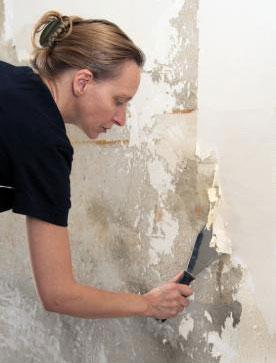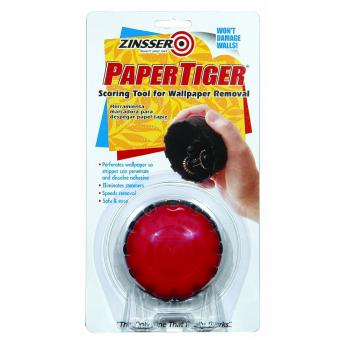
There are few home updates more visually rewarding than getting rid of peeling or dated wallpaper and replacing it with fresh paint or a new paper design. However, removing the old paper is only part of the job. Often, wallpaper leaves behind a sticky residue that can be difficult to remove. Depending on your needs and the type of paper you're dealing with, there are several ways to solve this problem.
Getting Rid of Wallpaper and Glue Together
If you haven't yet started stripping your wallpaper, you can start the glue-removal process from scratch. Often, if you start stripping the wallpaper the right way, you'll be left with little glue residue after the paper is gone.
Things You'll Need
You can save yourself some stress and maybe even an unplanned trip to Home Depot, if you assemble the tools you need before you start:
- Ladder
- Drop cloths, plastic, or sheets
- Garbage bags
- Bucket
- Garden sprayer
- Sponge, rags, towels
- Screwdriver
- Box to put switch covers and screws in
- Painter's tape
- Wallpaper-perforating tool, such as Zinsser Paper Tiger
- Gel wallpaper-removal solvent or warm water mixed with vinegar in a spray bottle
- Squeegee
- Scraping tool, such as a flexible three-inch putty knife
- Battery-operated lighting if you will be working at night
Remember, removing wallpaper and glue is a messy job. You'll want to dress in old clothes and wear shoes you don't care about. You should also wear protective gloves and safety goggles.
What to Do

- Turn the electricity to the room off before you start, since you'll be using a lot of water. Remove the switch covers and electrical outlet plates and tape the screws to the back of them. Put them in the box and set aside. Cover the openings of the outlets with painter's tape. Use a battery-operated light to illuminate the area if it's too dark to see without the electric lights.
- Remove as much furniture as you can from the room. Spread drop cloths over any remaining furniture. Also spread plastic sheets or drop cloths over the floor and tape the edges in place with painter's tape.
- Score the paper with the wallpaper-perforating tool to allow the water to reach the glue beneath it.
- Identify the type of paper you have. Newer wallpaper is often coated in vinyl, making it easy to clean. If this is the case with your wallpaper, use your putty knife to get under a loose corner of the paper and pull. This should allow you to remove most of the vinyl layer, leaving the paper backing. If you have traditional paper, simply continue to the next step.
- Add extremely hot water to a bucket, along with a capful of white vinegar. You can also use a wallpaper-removal solvent for tough jobs, mixing according to the manufacturer's instructions.
- Start with a three-foot section and spray the solution onto the wall using the garden sprayer. You want to really saturate the paper so that the solution comes in contact with the glue beneath. You can use a sponge to reach corners and other hard-to-spray areas. Allow this area to sit for about ten minutes. If you have drywall, use caution when applying the water; completely soaking the area can damage your wall.
- Place your wallpaper scraper under a saturated corner of the paper and begin scraping toward the center. The paper should lift fairly easily, bringing most of the glue with it. If it doesn't, spray it some more and give it a few more minutes to soak. Try again when it seems really saturated.
- Continue scraping the wallpaper section. As you remove a piece of paper, throw it in the garbage back right away. Otherwise, the glue will dry where it is sitting, causing the paper to stick to the floor and other surfaces.
- When you have completed the section, use the sponge to wipe off any remaining glue residue. Do this right away before moving on to the next section, so the glue residue doesn't dry on the wall.
- Use the squeegee to get rid of excess water, and wipe everything up with a towel.
- Continue working your way around the room section by section.
Should You Rent a Steamer?

Depending on the job, it may make sense to rent a wallpaper steamer from your local home improvement store for about $30 per day. Basically, a steamer pulls water from a reservoir and turns it into steam, which helps dissolve the glue. You press the steamer against the wall in sections and immediately peel that section off.
If you are renting a steamer, try to find a friend to help you peel the paper. This process works better with two people. Using a steamer is physically strenuous because you have to hold it on the wall for long periods, and this type of equipment isn't always necessary. You may want to rent a steamer if the following apply to your situation:
- You've tried removing the paper, and it's leaving a lot of glue residue behind.
- You are having trouble getting water to permeate the surface of the paper.
- You need to get the job done quickly.
Removing the Glue After the Paper Is Gone
Sometimes, even the best wallpaper removal job will leave sticky glue residue on your wall. If this glue dries in place, it can be a hassle to remove. Fortunately, there are several methods that can help.
Removing Glue with Piranha Gel Wallpaper Remover

Piranha Gel Wallpaper Remover gets consistently great reviews from Lowes users for its effectiveness. Designed to remove stubborn wallpaper glue or paste, this product works before or after peeling off the paper. It's non-toxic and safe for the environment, so there are no worries about harmful chemicals in your home.
If you've already removed the paper, this is how you can use it to get rid of any remaining glue:
- Set the nozzle to spray.
- Saturate the area with the product.
- Allow the product to sit on the wall for about 15 minutes.
- Use a wallpaper scraper to remove the glue residue.
- Use a dampened sponge to finish cleaning the wall.
Removing Glue with Simple Strip Power Solution
Another popular product is Simple Strip Power Solution, which uses enzymes to break down the bonds in the wallpaper adhesive. You can use it before or after peeling off the paper. Users on Amazon.com praise this product for being far less messy than gel removers or traditional methods. You can also purchase Simple Strip in the form of sheets you apply directly to the wall.
Here's how you use it:
- Score any remaining sections of wallpaper.
- Apply the product to the wall, concentrating on areas with excess glue.
- Allow the product to soak on the wall for 30 minutes.
- Use a scraper to remove the glue and bits of paper.
- Rinse off the wall with a damp sponge.
Removing Glue with Fabric Softener
If you're interested in trying a product you already have around your home, some people find that mixing fabric softener with warm water works well. Because some fabric softeners are thinner than others, you may need to experiment with different solution amounts.
Here's how to try it:
- Mix three parts fabric softener and one part warm water.
- Place the solution in a spray bottle, making sure you label the bottle.
- Divide your work area into sections, working on one wall at a time. Begin by spraying a wall, then let the softener penetrate the glue for about five minutes.
- After the softener has had time to work, begin scraping the glue off the wall. You'll need to use a plastic scraper as opposed to a metal one to keep from gouging the wall as you work.
- Keep plenty of paper towels on hand, as well as a garbage can. You'll need to continuously wipe all the gooey glue and softener mixture off the scraper.
- Once you've removed the majority of the glue, wipe the walls clean with a damp cloth.
Removing Glue with Dishwashing Liquid

According to HGTV, another method that has been proven to work for some people is to create a mixture of dishwashing liquid and hot water. Here's how to do it:
- Mix about two tablespoons of dishwashing liquid into a one-gallon bucket of hot water.
- Apply the solution to the walls either with a spray bottle or with a sponge.
- Wait about five minutes, then add a second coating of the mixture.
- Wait another five or 10 minutes, then begin scraping the glue off the wall. Again, you should use a plastic scraper as opposed to a metal one to keep from damaging the walls.
- Once you've removed most of the glue, wipe the walls clean with warm water.
You may need to wipe and dry several times before the wall is completely clean and ready for paint.
Try More Than One Method
Removing wallpaper adhesive can take time and patience. If one method doesn't work for you, try another. You're sure to find a product or technique that will leave your walls clean and ready for redecorating.







